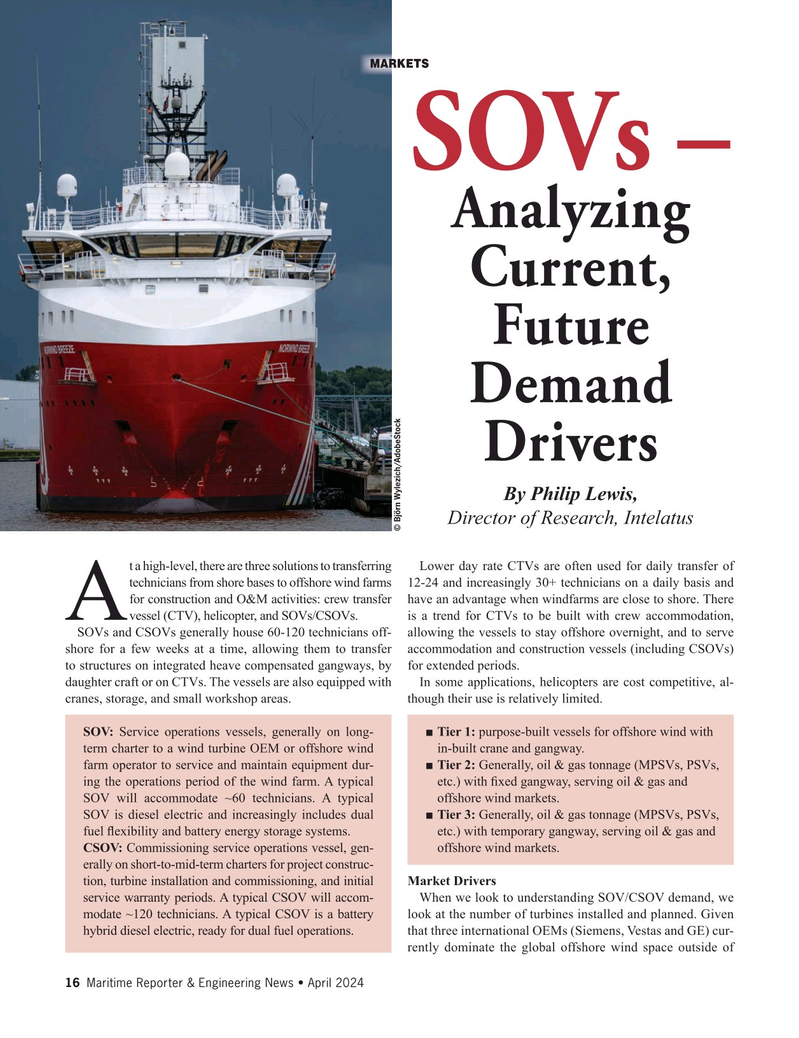
Page 16: of Maritime Reporter Magazine (April 2024)
Read this page in Pdf, Flash or Html5 edition of April 2024 Maritime Reporter Magazine
MARKETS
SOVs –
Analyzing
Current,
Future
Demand
Drivers
By Philip Lewis,
Director of Research, Intelatus © Björn Wylezich/AdobeStock t a high-level, there are three solutions to transferring Lower day rate CTVs are often used for daily transfer of technicians from shore bases to offshore wind farms 12-24 and increasingly 30+ technicians on a daily basis and for construction and O&M activities: crew transfer have an advantage when windfarms are close to shore. There
A vessel (CTV), helicopter, and SOVs/CSOVs. is a trend for CTVs to be built with crew accommodation,
SOVs and CSOVs generally house 60-120 technicians off- allowing the vessels to stay offshore overnight, and to serve shore for a few weeks at a time, allowing them to transfer accommodation and construction vessels (including CSOVs) to structures on integrated heave compensated gangways, by for extended periods.
daughter craft or on CTVs. The vessels are also equipped with In some applications, helicopters are cost competitive, al- cranes, storage, and small workshop areas. though their use is relatively limited.
SOV: Service operations vessels, generally on long- ¦Tier 1: purpose-built vessels for offshore wind with term charter to a wind turbine OEM or offshore wind in-built crane and gangway.
farm operator to service and maintain equipment dur- ¦Tier 2: Generally, oil & gas tonnage (MPSVs, PSVs, ing the operations period of the wind farm. A typical etc.) with ? xed gangway, serving oil & gas and
SOV will accommodate ~60 technicians. A typical offshore wind markets.
SOV is diesel electric and increasingly includes dual ¦Tier 3: Generally, oil & gas tonnage (MPSVs, PSVs, fuel ? exibility and battery energy storage systems. etc.) with temporary gangway, serving oil & gas and
CSOV: Commissioning service operations vessel, gen- offshore wind markets.
erally on short-to-mid-term charters for project construc- tion, turbine installation and commissioning, and initial Market Drivers service warranty periods. A typical CSOV will accom- When we look to understanding SOV/CSOV demand, we modate ~120 technicians. A typical CSOV is a battery look at the number of turbines installed and planned. Given hybrid diesel electric, ready for dual fuel operations. that three international OEMs (Siemens, Vestas and GE) cur- rently dominate the global offshore wind space outside of 16 Maritime Reporter & Engineering News • April 2024
MR #4 (1-17).indd 16 4/5/2024 8:40:17 AM

 15
15

 17
17
